And just like that Barcelona have secured their eighth La Liga trophy for their rich cabinet. Levante proved to be a worthy opponent, regardless of their low positioning in the table, but the last three points the Blaugrana needed went with them back to Catalunya after all. The new champs started the game with depleted ranks but were forced to call upon Lionel Messi from the bench to shift the tides once again.
This tactical analysis will explain how Barcelona sealed the deal on their home turf and wrapped the league up with three fixtures to go until the official end of the season.
Lineups
Barcelona (4-3-3)
Starting XI: Ter Stegen – Semedo, Piqué, Lenglet, Alba – Vidal, Rakitić, Arthur – Dembélé, Suárez, Coutinho
Bench: Cillessen, Umtiti, Aleñá, Sergi, Busquets, Messi, Malcom
Coach: Ernesto Valverde
Levante (4-1-4-1)
Starting XI: Aitor – Moses, Coke, Vezo, Rober, Luna – Rochina, Vukčević, Campaña – Mayoral, Jason
Bench: Oier, Cabaco, Pedro López, Bardhi, Morales, Dwamena, Martí
Coach: Paco López
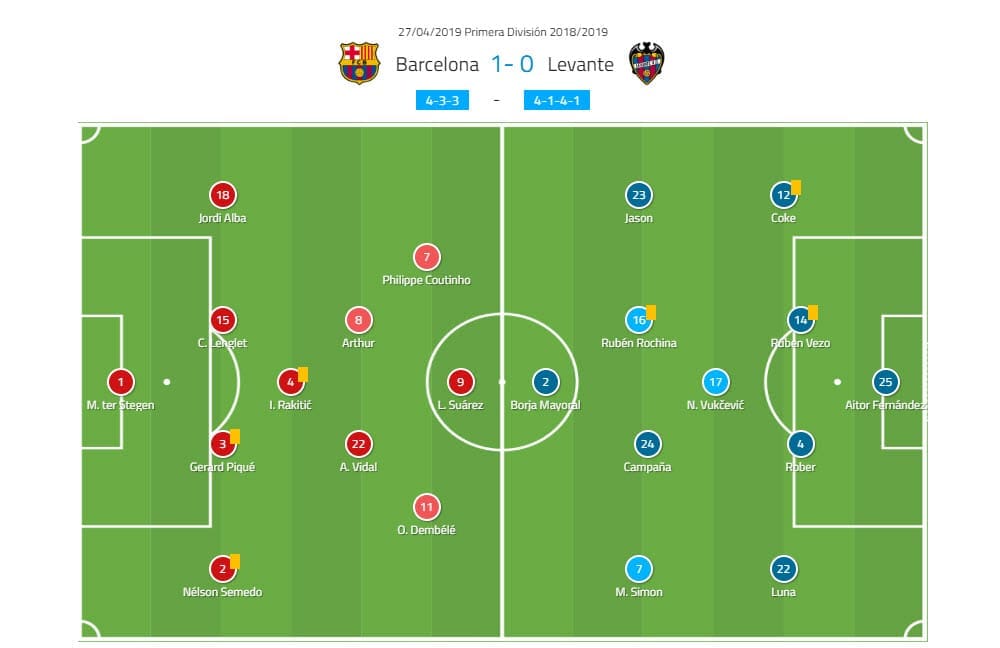
Barcelona’s setup
Even though this was a huge game for Barcelona, Ernesto Valverde decided to rotate his squad just a bit with that Liverpool clash still looming around the corner. With that in mind, Lionel Messi and Sergio Busquets dropped to the bench while Arturo Vidal and Ousmane Dembélé got their chance from the get-go.
In that system, Ivan Rakitić dropped to the “hole” as the team’s pivot, and Vidal accompanied Arthur Melo further up the pitch in midfield. The front trident consisted out of Ousmane Dembélé, Philippe Coutinho and Luis Suárez.
Nélson Semedo also got the nod in front of Sergi Roberto in the right-back position and the team was deployed in their familiar 4-3-3 system, which was changed to a more defensive minded 4-4-2 as we approached the final stages of the game.
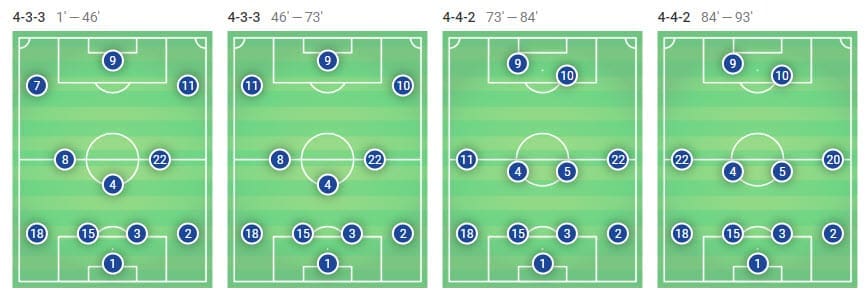
Levante’s setup
The visitors’ lineup saw three changes to the one that thrashed Real Betis 4-0 in their last fixture at home. Paco López decided to shuffle his deck just a bit considering the opponent and the venue. His defensive line and the goalkeeper were mostly the same apart from the change in the left-back position as the experienced Coke replaced his compatriot Tono.
Moving further up the pitch, Nikola Vukčević was the link between the defence and midfield just behind the quartet in front of him. Rubén Rochina returned from his suspension directly to the starting XI as Bardhi dropped back to the bench. The other newcomer was Moses Simon who occupied the wide position on the left. The ex-Madrid boy, Borja Mayoral was the lone striker on the night.
Levante were deployed in a 4-1-4-1 system throughout the whole game at the Camp Nou.
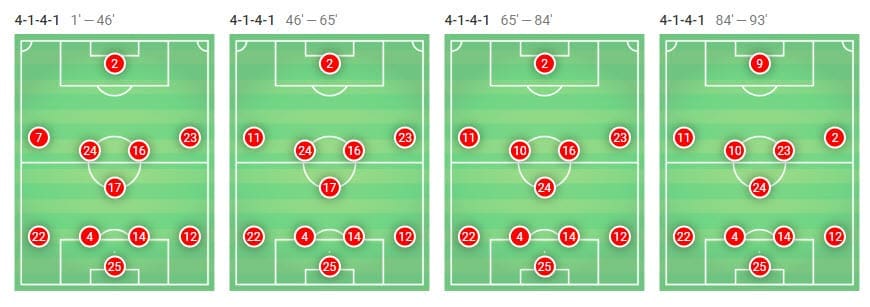
The game of two halves
The first half of this game definitely went in Barcelona’s favour by a large margin. The hosts were successful in pinning the opposition down and reduced them only to long balls toward their forwards or finding spaces through the flanks. Levante did not pose much threat in the opening 45 minutes but when they did find chances, those would come through crosses into the box.
Finding the wide man in a good position for a cross was essential when going forward but was also relatively easy to accomplish or rather, it was the only way they could bypass Barcelona’s intense pressing mechanism. Upon losing the ball, the Catalans would always collapse on their opposition in an attempt to quickly regain the possession, but in cases when that would not entirely work, Levante found themselves in good positions to strike a quick counter.
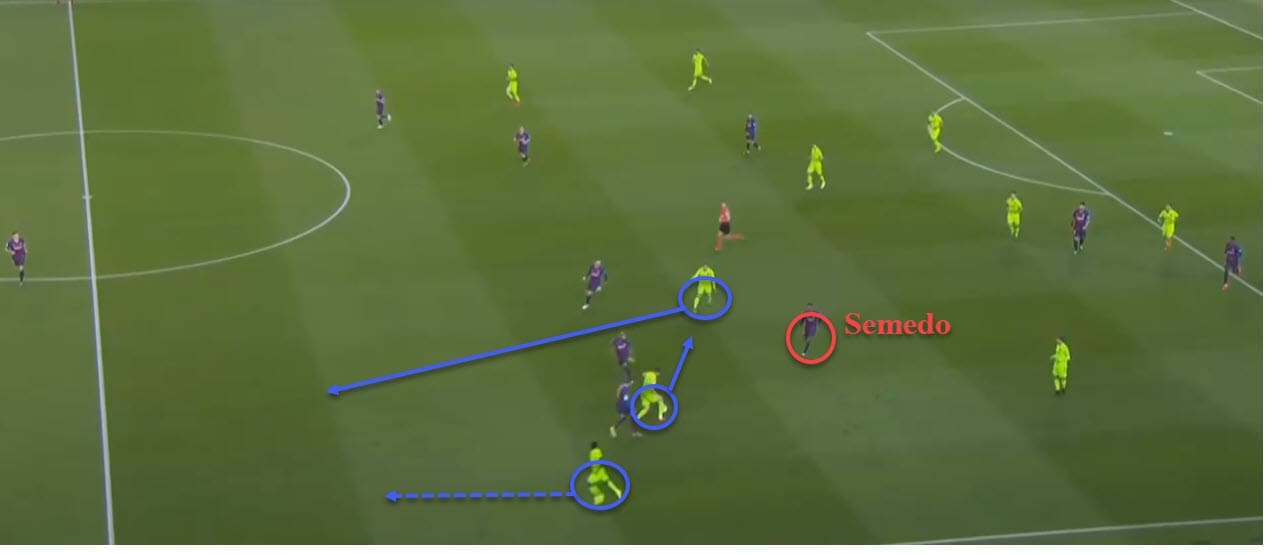
The main thing to note in the example above is how these said transitions were only possible due to Barcelona’s full-backs always being extremely high up the pitch. Notice how Semedo is closer to the opposition’s box than to the middle of the pitch. A quick one-two sends Levante sprinting towards Barcelona’s half but a well-timed tackle prevents further damage for the home team.
Still, those were the only instances when Levante could harm their hosts, who, in turn, had a similar approach in mind; utilising both of their wings when attacking. The combination of Semedo and Dembélé on the right and Coutinho and Alba on the left seems to be the one that works very well for Valverde.
Barcelona relied on quick swapping of sides to find their wide man unmarked since Levante were mostly defending via zonal marking as opposed to tight man-marking. Notice in the image below how most of Levante’s troops shift to the side where the ball is, leaving the other flank unoccupied by their defenders.
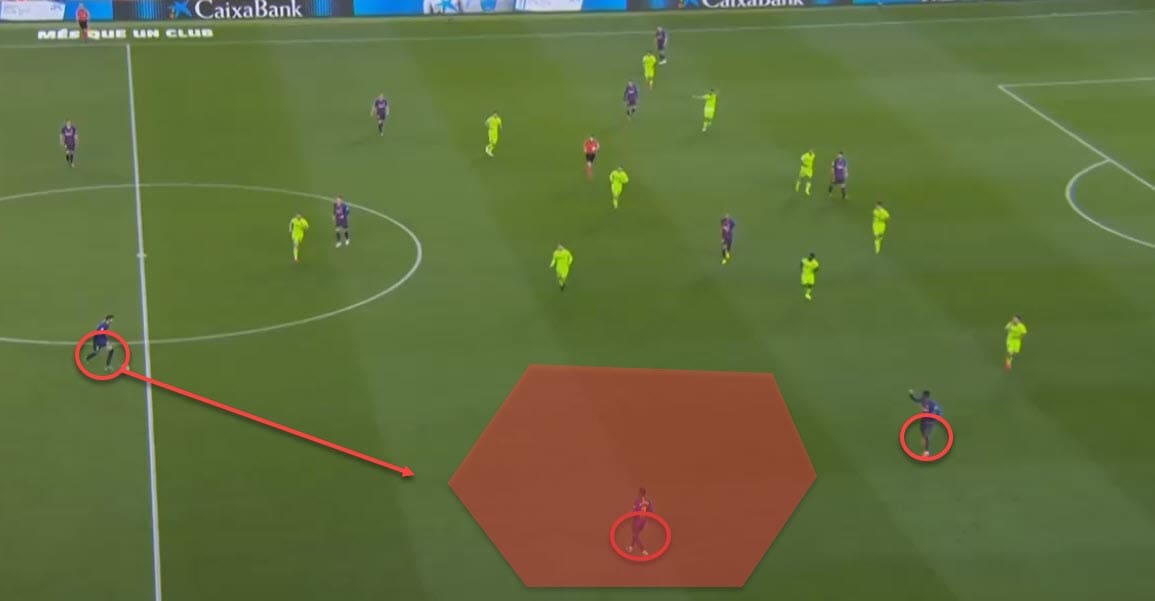
This gives Barcelona a clear entrance to the final third if they can move the ball quick enough, which they did most of the time. Dembélé would also drop a bit deeper to receive the ball and then carry it forward with pace. They still had to deal with the clearly compact shape of Levante who had no problem sitting deep and absorbing pressure.
The way Barcelona played around that was with constant movements and changes of direction, forcing defenders out of their shape and markers away from their men. The image below shows how Semedo and Dembélé combine well. The Frenchman covers enough ground with his sprint, releases the ball in time and continues towards the box, dragging two markers with him and opening up the necessary space for Semedo to receive the pass from Vidal.
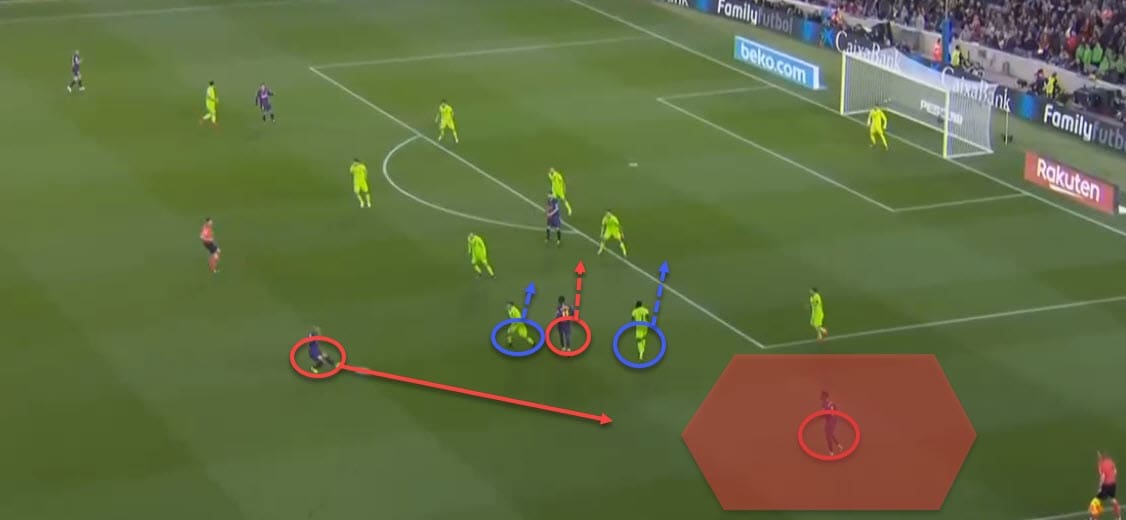
In this situation, Barcelona had two options: try for a cross, which they did 15 times throughout the game with no palpable success, or circle around until they find a suitable channel to send the ball through.
The action would follow the same steps on the other side, as well. Coutinho and Alba made for a good combination since the Brazilian would mostly occupy the half-spaces, letting the Spaniard overlap freely. They faced the same problem as their teammates on the right: Levante made sure to create overloads which forced Barcelona to either commit more men in the wide areas or to get creative, as was shown in the previous example for the right wing.
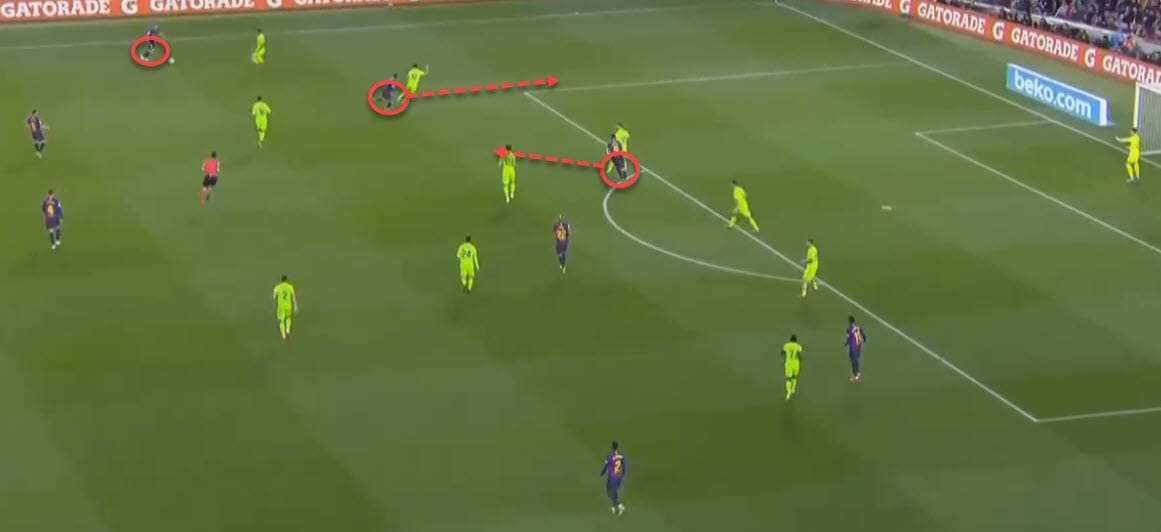
Here, Coutinho makes a run, dragging his marker with him, which opens up space for Luis Suárez to exploit. The Uruguayan drops to the free area, taking one of the centre-backs with him and opening the space for Coutinho again. Even though Barcelona couldn’t score any goals from those attacking actions, they did create a couple of good goal-scoring opportunities.
It’s also important to note that, more often than not, those situations arose from individual skill which was used to unlock a sturdy defence, but was then followed by the similar skill shown between the sticks from Aitor Fernández Abarisketa who racked up a total of 11 saves.
In general, Levante were happy letting Barcelona occupy the flanks since they had the confidence to beat their hosts in the air. Eight out of 13 aerial duels went in their favour on the night but surprisingly enough, only one happened in their own box. A similar narrative can be seen in their tackle map, which is presented below.
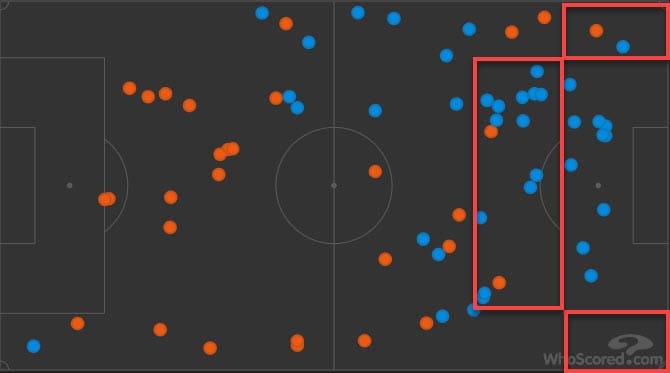
Notice how there are almost no tackles present on the flanks, indicating that Levante were happy letting Barcelona play from those areas since they expected to win the crossed balls. The Catalans were also aware of the fact that their strengths lie elsewhere, so a ball cut back towards the edge of the box was always more likely, thus explaining the big amount of Levante’s tackles present in that area.
The Catalans’ tendency to go down the left, once again, can also be seen from the graph above since most of Levante’s defensive efforts were indeed present on that specific flank.
The opening stages of the game, as well as most of that first half, was definitely Barcelona’s to command. The key was to constrict Levante’s movements on the ball by pressing them extremely well. The visitors couldn’t keep hold of the ball, as their stats clearly indicate with only 38% possession to their name.
Barcelona had them trapped and pinned down but since they couldn’t capitalise or breach the compact and narrow shape they faced when entering the opposition’s half, Levante were happy to let things play out the way they were so far. With the half-time whistle going off from the referee, the hosts’ alarms were slowly being raised and questions asked.
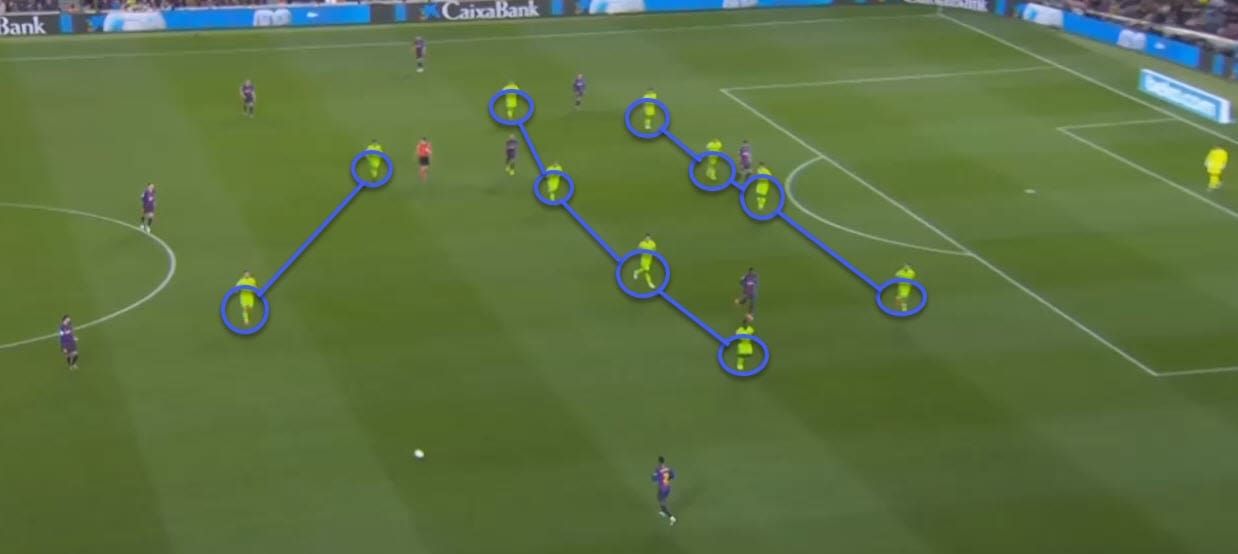
“In case of emergency, break the Messi glass”
The second half saw some changes in the personnel of both camps. Philippe Coutinho had to exit the pitch regardless of his good performance and José Morales was subbed on for Simon Moses on the other side. Levante made a change within their troops but the gameplan remained the same, at least for the time being.
For Barcelona, however, it meant that Ousmane Dembélé would revert to the left side while Messi was back on his usual right (on paper). Even though the Argentine magician was definitely making an improvement going forward as a whole, Barcelona’s goal came from individual brilliance across the pitch.
What Barcelona did get with his inclusion was a greater pressure attraction point as Messi was mostly covered by multiple markers, leaving more space for his teammates. The Catalans managed to capitalise on exactly that: inviting and dispersing of pressure.
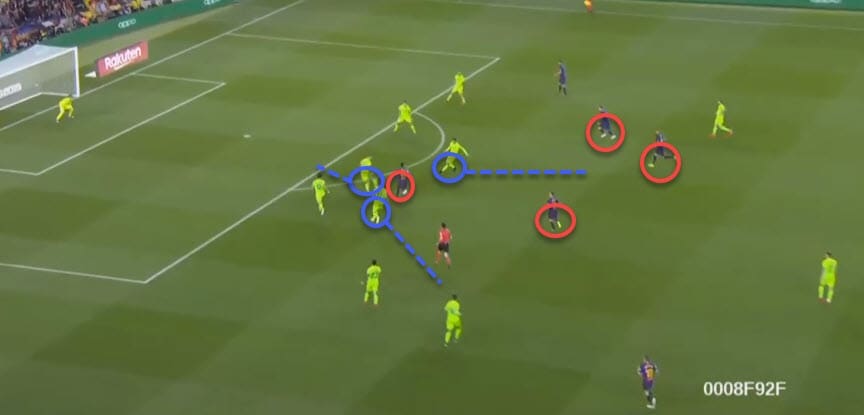
After his great run, dribbling past multiple defenders, Dembélé gets collapsed upon but he releases the ball in time, dispersing that pressure and freeing his teammates. This was essential in Barcelona’s progression into the free zones of the pitch and was the only way they were getting past the compact block.
In the end, it was Messi’s skill to get rid of two defenders and his exceptional finishing that put them into the lead, but that provoked Levante to get out of their shell, and the bumpy ride was only starting.
The tides suddenly shift in Levante’s favour
As soon as they scored the goal, Barcelona stopped pushing the gas pedal and slowed down. Levante, on the other hand, knew they had to start attacking because a goalless draw was no longer on the table.
This sudden shift of the tides is best seen in the possession stats presented below. The first half was clearly all Barcelona but the second half saw a drastic change. Levante were slowly but steadily clawing back into the game and regaining control.
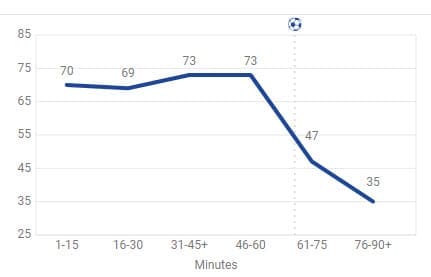
The biggest thing to notice is the 60th-minute mark in which the goal was scored by Messi. From that point onwards it was only downhill for Barcelona. Their intensity was not as high anymore and Levante’s, in turn, rose immensely. The away team was suddenly more aggressive than ever and this gave them a total of 63 recoveries to go along with Barcelona’s 84 losses of possession.
Suddenly, with both Messi and Suárez staying in the opposition’s half most of the time, Barcelona defended with fewer men and were not as aggressive in their press anymore. Levante had an easier task building their attacks up since the Catalans always had to pull men from deeper positions in order to maintain the high press.
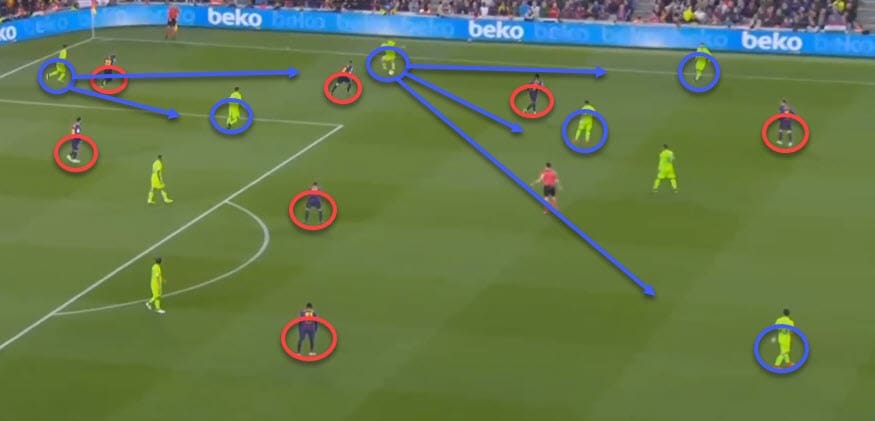
Notice in the image above how Barcelona’s attacking trio doesn’t participate in the press as much, which leaves the job to the midfielders. But that gives Levante the chance of creating numerical superiorities in deeper positions, and in turn using that to beat the press and advance further up the pitch.
That also made their transitions even more deadly as they attacked with pace and numbers, both of which Barcelona seemed to lack, especially in the latter stages of the game. Every lost ball higher up the pitch meant that there were fewer troops available to defend.
This did lead the Catalans into dangerous situations so Valverde subbed in Sergi Roberto and Sergio Busquets to stabilise the game. Barcelona then reverted to a 4-4-2 formation with only Messi and Suárez staying up front.

Levante took a page from Barcelona’s book when it came to attacking. They would target the flanks once again in quick transitions that now seemed even more effective but unfortunately for them, did not yield them any results.
At the end of the day, Barcelona successfully shut the door on their guests, leaving their net unrattled and securing the title.
Conclusion
A 26th La Liga title is already safe and sound in Barcelona’s trophy cabinet as Ernesto Valverde clenches his second and Lionel Messi his 10th. Interestingly enough, the Basque coach has now only lost three games in his two-year tenure as the Catalans’ coach, having played a total of 73. His pragmatic approach may have been questioned numerous times before but the results simply cannot be.
As for Levante, they have shown multiple times this season that even though they are a bottom of the table team on paper, they pack a big punch and can tango with the best teams in Spain. After all, they were the ones who administered Barcelona their one and only defeat last season and were close to spoiling their triumphs on Saturday evening, as well.
Now that La Liga is all done and dusted, Barcelona will undoubtedly give a chance to some other players in their squad and the focus will once again return to the Champions League clash on Wednesday. Liverpool awaits.
If you love tactical analysis, then you’ll love the digital magazines from totalfootballanalysis.com – a guaranteed 100+ pages of pure tactical analysis covering topics from the Premier League, Serie A, La Liga, Bundesliga and many, many more. Buy your copy of the April issue for just ₤4.99 here, or even better sign up for a ₤50 annual membership (12 monthly issues plus the annual review) right here.

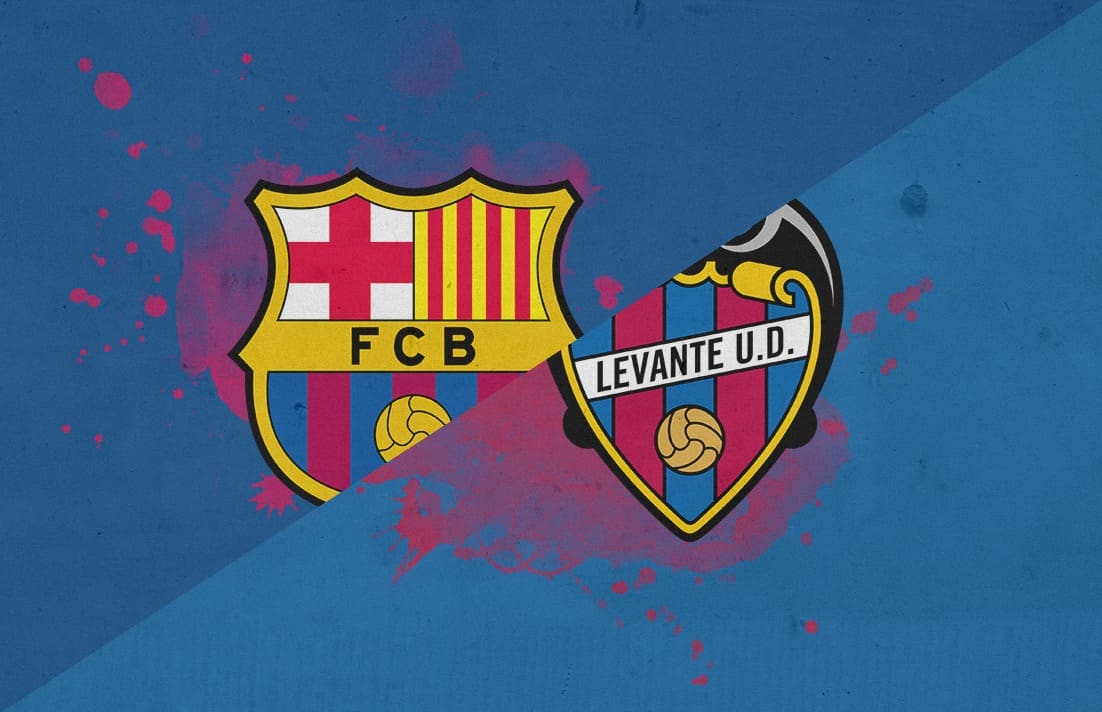




Comments